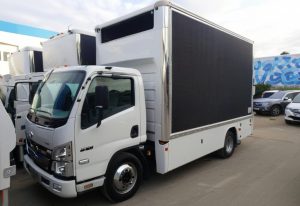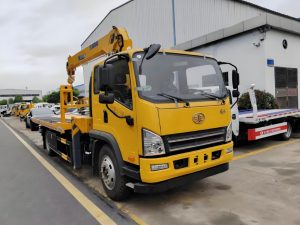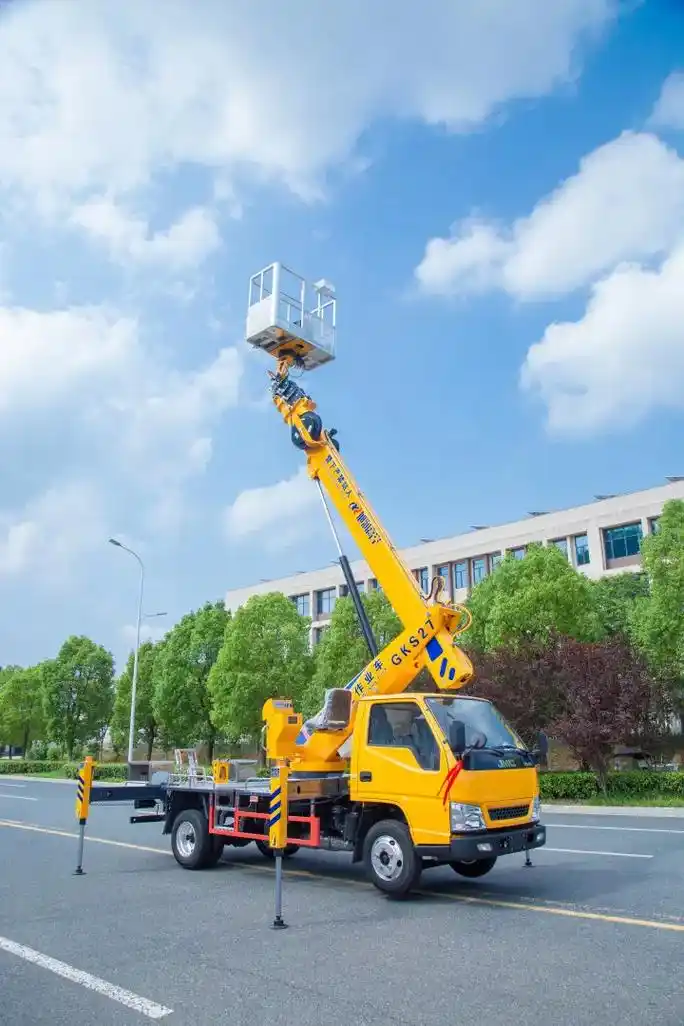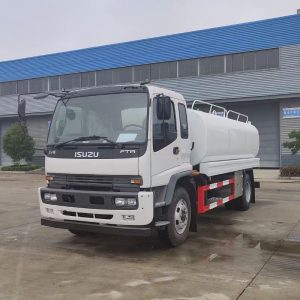Table of Contents
Toggle
Introduction
In the vast world of transportation and logistics, few vehicles command as much respect and utility as the flatbed truck. Imagine a Swiss Army knife, but on wheels – that’s essentially what a flatbed truck represents in the transport industry. They are versatile, robust, and an indispensable asset for various sectors ranging from construction to agriculture. Picture this: you’re tasked with moving an oversized load that can’t fit into a standard enclosed truck. What do you turn to? A flatbed truck, of course! These workhorses can haul everything from steel beams and lumber to heavy machinery and even large agricultural equipment.
Flatbed trucks play a crucial role in the global supply chain, ensuring that goods reach their destinations safely and efficiently. Their unique design offers flexibility that other types of trucks simply cannot match. But what exactly makes them so special? Why do industries rely so heavily on these open-stage giants? Let’s embark on a journey to uncover the intricacies of flatbed trucks, exploring their types, uses, advantages, challenges, and much more.
What is a Flatbed Truck?
To understand the allure and functionality of flatbed trucks, we first need to grasp what they are fundamentally. At its core, a flatbed truck is a type of vehicle characterized by an entirely flat, level bed with no sides or roof. This open design is what sets it apart from other trucks, allowing for easy loading and unloading of goods. Imagine trying to fit a large piece of machinery into a standard enclosed truck – it’s like trying to fit a square peg into a round hole. A flatbed truck eliminates these constraints by providing an open platform that can accommodate oversized and irregularly shaped items.
The structure of a flatbed truck is straightforward yet highly effective. The flatbed is typically constructed from sturdy materials such as steel or aluminum to support heavy loads. The absence of sides and a roof means that cargo can be loaded from any angle – front, back, or sides – using various equipment like forklifts, cranes, or even manually.
But how does a flatbed truck compare to other types of trucks? Enclosed trucks, for example, are great for transporting goods that need protection from the elements. However, their enclosed nature limits the size and shape of the cargo they can carry. On the other hand, flatbed trucks offer unparalleled flexibility, making them ideal for transporting large, bulky items that wouldn’t fit inside an enclosed space. It’s like comparing a toolbox to an open workbench; both have their uses, but the workbench offers more room for maneuverability.
Types of Flatbed Trucks
Not all flatbed trucks are created equal. Just as there are different tools for different tasks, various types of flatbed trucks cater to specific transportation needs. Understanding these types can help businesses choose the right flatbed truck for their particular requirements.
- Standard Flatbed: The standard flatbed is the most common type and serves as the go-to option for transporting a wide range of goods. It features a simple, flat platform that can handle anything from pallets of goods to construction materials. The versatility of the standard flatbed makes it a favorite among transport companies.
- Step Deck Flatbed (Drop Deck): The step deck flatbed, also known as a drop deck, features two deck levels – an upper deck near the cab and a lower deck towards the rear. This design allows for taller loads to be transported without exceeding height restrictions set by road regulations. The lower deck sits closer to the ground, providing additional height clearance for tall cargo like large machinery or stacked containers.
- Double Drop Deck Flatbed: Taking the concept of height accommodation even further is the double drop deck flatbed. This type has two drops in deck height – one between the upper deck and the lower deck, and another towards the rear. The middle section of the bed is significantly lower than both ends, allowing for extremely tall cargo while maintaining stability by keeping the center of gravity low. It’s ideal for transporting items such as industrial equipment or oversized construction materials.
- Extendable Flatbed: Sometimes referred to as a stretch flatbed, this type features an adjustable bed length that can be extended or contracted based on the size of the load. This adaptability makes it perfect for hauling long items like pipes, beams, or large pieces of equipment that vary in length.
- Removable Gooseneck (RGN) Flatbed: An RGN flatbed truck has a detachable front that allows the trailer to drop down to the ground, creating its own ramp. This feature makes loading and unloading heavy machinery straightforward, especially when driving onto the trailer is necessary. RGNs are particularly useful for transporting heavy construction equipment such as bulldozers or cranes.
- Conestoga Flatbed: The Conestoga flatbed combines the best of both worlds – the flexibility of a flatbed with the protective benefits of an enclosed trailer. It features a rolling tarp system that covers the cargo when needed and can be retracted for easy loading and unloading. This type is ideal for transporting weather-sensitive items without sacrificing loading convenience.
Each type of flatbed truck brings its own set of advantages tailored to specific transportation needs. For instance, if you’re in the construction industry needing to transport steel beams or heavy machinery, a step deck or double drop deck might be your best bet due to their height accommodation capabilities. On the other hand, if you need flexibility in load length without compromising on protection from weather elements, an extendable or Conestoga flatbed could be the ideal choice.
Understanding these variations helps businesses make informed decisions when selecting a flatbed truck for their operations, ensuring that they choose a vehicle that not only meets their immediate needs but also provides long-term value in terms of versatility and efficiency.
Common Uses of Flatbed Trucks
Flatbed trucks are the unsung heroes of numerous industries. Their design makes them exceptionally versatile, allowing them to transport a variety of goods that other trucks simply can’t handle. Let’s take a closer look at some of the most common uses of flatbed trucks across different sectors:
- Construction Industry: The construction industry is perhaps the most significant user of flatbed trucks. These vehicles are perfect for transporting building materials like steel beams, lumber, bricks, and scaffolding. Given their open design, flatbed trucks make it easy to load and unload these heavy and often oversized items directly at construction sites. Imagine trying to maneuver a 20-foot steel beam into an enclosed truck – it’s just not feasible. Flatbed trucks eliminate this hassle, providing an open stage for all sorts of construction materials.
- Agriculture Sector: In agriculture, flatbed trucks are indispensable for moving large equipment such as tractors, combines, and hay bales. They can also transport bulk items like sacks of grain or fertilizer. The flexibility of a flatbed truck means that farmers can load their goods quickly and efficiently, saving time and labor. Think of it as having a giant wheelbarrow that can carry tons of produce and machinery across long distances.
- Transporting Heavy Machinery: When it comes to moving heavy machinery like excavators, bulldozers, and industrial equipment, flatbed trucks are the go-to option. Their sturdy construction and open design allow for the safe and secure transport of these massive machines. Additionally, types like the Removable Gooseneck (RGN) flatbed make it easier to load and unload heavy equipment by creating a ramp from the ground.
- Logistics and Freight Companies: Logistics companies often rely on flatbed trucks to transport large quantities of palletized goods or oversized freight that doesn’t fit in standard containers. This includes everything from pipes and metal coils to large crates and construction components. The ability to load from any angle makes flatbeds highly efficient for these operations.
- Wind Energy Sector: The renewable energy sector, particularly wind energy, utilizes flatbed trucks to transport long wind turbine blades and other components. These parts are often too large for enclosed trailers, making flatbeds the ideal choice. The extendable flatbed variant is particularly useful here as it can accommodate the varying lengths of turbine blades.
- Military Applications: Flatbed trucks are also employed in military logistics for transporting vehicles, equipment, and supplies. Their robust design ensures that even the heaviest military hardware can be moved efficiently. The ability to quickly load and unload is crucial in military operations where time is of the essence.
- Disaster Relief: In times of natural disasters or emergencies, flatbed trucks play a critical role in transporting relief supplies such as food, water, medical equipment, and temporary shelters. Their ability to carry large quantities and oversized items makes them ideal for rapid response efforts.
Advantages of Using Flatbed Trucks
So why are flatbed trucks so popular across these diverse applications? Here are some compelling advantages that make them stand out:
- Versatility: One of the most significant benefits of flatbed trucks is their versatility. They can carry almost anything – from construction materials and agricultural produce to heavy machinery and military equipment. This adaptability makes them a valuable asset for businesses that need to transport a wide range of goods.
- Ease of Loading and Unloading: With no sides or roof to contend with, loading and unloading flatbed trucks is a breeze. Goods can be loaded from any angle using various equipment such as forklifts, cranes, or even manually. This feature significantly reduces loading times and increases operational efficiency.
- Capacity to Carry Oversized Loads: Flatbed trucks are perfect for transporting items that are too large or irregularly shaped for enclosed trucks. Whether it’s long wind turbine blades or bulky construction machinery, flatbeds can handle these oversized loads with ease.
- Accessibility: The open design of flatbed trucks means they can be loaded and unloaded in places where space is limited or where access might be challenging for enclosed trailers. This makes them particularly useful in construction sites, farms, or remote locations.
- Customizability: Many flatbed trucks come with customization options such as removable sides, winches, toolboxes, and extendable beds. These features allow businesses to tailor their flatbeds to specific needs, enhancing functionality and convenience.
- Cost-Effectiveness: Due to their simple design and robust construction, flatbed trucks are often more cost-effective than specialized enclosed trailers. Their ability to carry a wide variety of loads also means businesses can get more use out of a single vehicle.
- Durability: Built to withstand heavy loads and rough conditions, flatbed trucks are incredibly durable. They are constructed from high-quality materials like steel or aluminum that can endure significant wear and tear, ensuring a long lifespan with proper maintenance.
Disadvantages and Challenges
Of course, no vehicle is without its drawbacks, and flatbed trucks have their own set of challenges:
- Exposure to Weather Conditions: One of the most notable disadvantages of flatbed trucks is that cargo is exposed to the elements. Rain, snow, wind, and even intense sunlight can affect the goods being transported unless they are covered with tarps or other protective materials.
- Load Security Concerns: Ensuring that cargo is properly secured on a flatbed truck can be challenging and time-consuming. Improperly secured loads pose significant safety risks not only to the driver but also to other road users. Specialized tie-downs and regular checks are essential to mitigate these risks.
- Higher Fuel Consumption: Flatbed trucks generally have higher fuel consumption compared to enclosed trucks due to their less aerodynamic design. The open bed creates more air resistance, leading to increased fuel costs over long distances.
- Limited Protection Against Theft: Because cargo on a flatbed truck is exposed, it is more vulnerable to theft compared to goods transported in an enclosed trailer. Security measures such as locks, chains, and surveillance systems may be necessary to protect valuable loads.
- Loading Challenges for Certain Cargo Types: While flatbeds excel at transporting large or irregularly shaped items, they may not be suitable for small or loose items that require containment during transit. These types of cargo might be better suited for enclosed trailers.
- Regulatory Compliance: Transporting oversized loads on flatbed trucks often requires special permits and adherence to specific regulations regarding weight limits, dimensions, and safety measures. Navigating these regulatory requirements can be complex and time-consuming.
Despite these challenges, the advantages of using flatbed trucks often outweigh the disadvantages for many businesses. Proper planning, secure loading practices, and routine maintenance can help mitigate most of the drawbacks associated with these versatile vehicles.
Choosing the Right Flatbed Truck
Selecting the right flatbed truck for your needs can feel like choosing the right tool from a vast toolbox. It requires careful consideration of several factors to ensure you get the best fit for your specific requirements. Here are some essential points to ponder:
- Type of Cargo: The type of cargo you intend to transport plays a significant role in determining the right flatbed truck. Are you hauling heavy machinery, construction materials, or agricultural products? Different types of flatbeds, such as step decks or RGNs, cater to specific cargo needs. For instance, if you’re transporting tall loads, a step deck or double drop deck would be more suitable.
- Load Dimensions and Weight: Understanding the dimensions and weight of your typical loads is crucial. Flatbed trucks come in various sizes and weight capacities. Ensure that the flatbed you choose can accommodate your heaviest and bulkiest items without exceeding legal weight limits. Overloading can lead to fines and safety hazards.
- Distance and Frequency of Use: Consider how often and how far you’ll be using the flatbed truck. If you’re covering long distances frequently, fuel efficiency becomes a vital factor. Additionally, frequent use may require a more durable and low-maintenance option to minimize downtime.
- Customization Needs: Do you need additional features such as removable sides, winches, or toolboxes? Customization options can enhance the functionality of your flatbed truck, making it more versatile for your specific operations. For example, an extendable flatbed is ideal for varying load lengths.
- Budget Constraints: Budget is always a key consideration. While it’s tempting to go for the most feature-rich option, ensure that it aligns with your financial constraints. Consider both the initial purchase cost and long-term maintenance expenses.
- Regulatory Compliance: Be mindful of the regulatory requirements in your region. Some types of loads may require special permits or adherence to specific safety standards. Ensure that your chosen flatbed truck complies with all relevant regulations to avoid legal complications.
- Brand and Dealer Reputation: Purchasing from reputable brands and dealers can provide peace of mind regarding quality and after-sales support. Research customer reviews and ratings to gauge the reliability and service standards of potential vendors.
Maintenance and Care
Maintaining a flatbed truck is akin to caring for a prized possession – regular upkeep ensures longevity and optimal performance. Here are some essential maintenance tips:
- Regular Inspections: Conduct routine inspections to check for wear and tear on critical components such as the bed, tires, brakes, and securing mechanisms. Look for signs of rust, cracks, or any other damage that could compromise safety.
- Keep the Bed Clean: Regularly clean the flatbed to prevent the buildup of dirt, debris, and corrosive materials that can lead to rust and deterioration. A clean bed also ensures better load security by providing a stable surface.
- Check Tire Pressure: Maintaining proper tire pressure is crucial for safe handling and fuel efficiency. Under-inflated or over-inflated tires can lead to uneven wear and increase the risk of blowouts.
- Lubricate Moving Parts: Ensure that all moving parts, such as hinges and securing mechanisms, are well-lubricated to prevent rusting and ensure smooth operation. Regular lubrication also extends the lifespan of these components.
- Monitor Fluid Levels: Regularly check and top up essential fluids such as engine oil, coolant, brake fluid, and transmission fluid. Keeping fluid levels within the recommended range helps prevent mechanical issues.
- Inspect Lights and Signals: Ensure that all lights and signals are functioning correctly. This includes headlights, brake lights, turn signals, and marker lights. Proper lighting is essential for visibility and safety on the road.
- Secure Loose Components: Regularly check that all bolts, nuts, and securing components are tight and in good condition. Loose parts can lead to accidents or damage during transit.
- Follow Manufacturer Guidelines: Adhere to the maintenance schedule recommended by the manufacturer. Regular servicing by qualified technicians ensures that any potential issues are addressed promptly.
Safety Tips for Operating Flatbed Trucks
Safety should always be a top priority when operating flatbed trucks. Here are some essential safety tips to keep in mind:
- Proper Loading Techniques: Distribute weight evenly across the flatbed to avoid tipping or shifting during transit. Ensure that heavier items are placed towards the center of the bed for better stability.
- Securing Loads: Use appropriate tie-downs such as straps, chains, or ropes to secure the cargo firmly. Check tie-downs regularly during transit to ensure they remain tight and secure.
- Use Safety Equipment: Equip your flatbed truck with necessary safety equipment such as reflective vests, warning triangles, fire extinguishers, and first aid kits. These items are essential in case of emergencies.
- Adhere to Speed Limits: Follow speed limits and drive at a safe speed considering the load you’re carrying. Heavy loads increase stopping distances, so it’s crucial to maintain a safe speed to avoid accidents.
- Avoid Sudden Maneuvers: Avoid sudden braking or sharp turns that can cause the load to shift or tip over. Smooth and gradual maneuvers ensure better control of the vehicle.
- Conduct Pre-Trip Inspections: Before embarking on a trip, conduct a thorough inspection of the flatbed truck to ensure everything is in good working condition. Check tires, lights, brakes, and load security.
- Stay Alert: Stay vigilant and alert while driving, especially on long hauls. Fatigue can impair judgment and reaction times, so take regular breaks to rest and recharge.
- Follow Legal Requirements: Ensure compliance with all legal requirements such as load permits, weight limits, and safety regulations specific to your region.
Future Trends in Flatbed Trucking
The world of flatbed trucking is evolving with technological advancements and changing industry dynamics. Here are some future trends to watch out for:
- Technological Innovations: The integration of advanced technologies such as GPS tracking, automated loading systems, and telematics is making flatbed trucks smarter and more efficient. These innovations enhance route planning, load management, and overall operational efficiency.
- Electric Flatbed Trucks: With growing environmental concerns and stringent emission regulations, electric flatbed trucks are emerging as a viable alternative to traditional diesel-powered vehicles. Electric trucks offer lower emissions, reduced operating costs, and quieter operation.
- Autonomous Vehicles: The development of autonomous driving technology is set to revolutionize the trucking industry. While fully autonomous flatbed trucks may still be a few years away, advancements in driver-assistance systems are already improving safety and reducing driver fatigue.
- Sustainability Initiatives: The push towards sustainability is influencing the design and operation of flatbed trucks. Innovations such as lightweight materials, aerodynamic enhancements, and fuel-efficient engines are helping reduce the carbon footprint of these vehicles.
- Improved Load Security Systems: Advanced load security systems incorporating sensors, cameras, and automated tie-down mechanisms are enhancing cargo safety during transit. These systems provide real-time monitoring and alerts for any load shifts or security breaches.
- Enhanced Connectivity: The rise of IoT (Internet of Things) is enabling better connectivity between flatbed trucks, cargo, and logistics platforms. This connectivity facilitates real-time tracking, predictive maintenance, and seamless communication across the supply chain.
- Regulatory Changes: Evolving regulations related to emissions, safety standards, and load permits will continue to shape the flatbed trucking industry. Staying updated with these changes ensures compliance and avoids potential legal issues.
- Driver Training Programs: As technology advances, driver training programs are also evolving to equip drivers with the skills needed to operate modern flatbed trucks safely and efficiently. Training in areas such as autonomous systems operation and advanced load management is becoming increasingly important.
Conclusion
To wrap it all up, flatbed trucks are a vital component of modern logistics, offering unparalleled versatility and capacity for a wide range of cargo types. Despite some challenges like weather exposure and fuel consumption, their benefits far outweigh the drawbacks. As technology advances and environmental considerations come into play, flatbed trucking will continue to adapt and thrive in the ever-changing landscape of transportation.
By understanding how to choose the right flatbed truck for your needs, maintaining it properly, prioritizing safety during operation, and staying abreast of future trends, businesses can maximize the efficiency and longevity of these indispensable vehicles.







